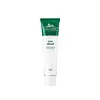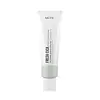What's inside
What's inside
 Key Ingredients
Key Ingredients

 Benefits
Benefits

 Concerns
Concerns

 Ingredients Side-by-side
Ingredients Side-by-side

Water
Skin ConditioningGlycerin
HumectantButylene Glycol
HumectantDimethicone
EmollientPEG-8 Caprylic/Capric Glycerides
EmulsifyingCetyl Ethylhexanoate
EmollientCetearyl Olivate
Acrylates/C10-30 Alkyl Acrylate Crosspolymer
Emulsion StabilisingSorbitan Olivate
EmulsifyingTromethamine
BufferingPhenoxyethanol
PreservativeAmmonium Acryloyldimethyltaurate/Vp Copolymer
Beeswax
Emulsion StabilisingChlorphenesin
AntimicrobialParfum
MaskingEthylhexylglycerin
Skin ConditioningCaprylyl Glycol
EmollientPanthenol
Skin ConditioningMelia Azadirachta Leaf Extract
Skin ConditioningArtemisia Princeps Leaf Extract
Skin ConditioningBenzophenone-5
UV AbsorberPortulaca Oleracea Extract
Skin ConditioningAlcohol
AntimicrobialDisodium EDTA
Melia Azadirachta Flower Extract
Skin ConditioningTheobroma Cacao Extract
Skin Conditioning1,2-Hexanediol
Skin ConditioningSodium Hyaluronate
HumectantDextrin
AbsorbentCentella Asiatica Extract
CleansingCaprylic/Capric Triglyceride
MaskingCeramide NP
Skin ConditioningHydrogenated Lecithin
EmulsifyingCinnamomum Camphora Leaf Extract
MaskingBeta-Glucan
Skin ConditioningPropolis Extract
Skin ConditioningAsiaticoside
AntioxidantMadecassoside
AntioxidantAsiatic Acid
Skin ConditioningWater, Glycerin, Butylene Glycol, Dimethicone, PEG-8 Caprylic/Capric Glycerides, Cetyl Ethylhexanoate, Cetearyl Olivate, Acrylates/C10-30 Alkyl Acrylate Crosspolymer, Sorbitan Olivate, Tromethamine, Phenoxyethanol, Ammonium Acryloyldimethyltaurate/Vp Copolymer, Beeswax, Chlorphenesin, Parfum, Ethylhexylglycerin, Caprylyl Glycol, Panthenol, Melia Azadirachta Leaf Extract, Artemisia Princeps Leaf Extract, Benzophenone-5, Portulaca Oleracea Extract, Alcohol, Disodium EDTA, Melia Azadirachta Flower Extract, Theobroma Cacao Extract, 1,2-Hexanediol, Sodium Hyaluronate, Dextrin, Centella Asiatica Extract, Caprylic/Capric Triglyceride, Ceramide NP, Hydrogenated Lecithin, Cinnamomum Camphora Leaf Extract, Beta-Glucan, Propolis Extract, Asiaticoside, Madecassoside, Asiatic Acid
Water
Skin ConditioningDimethicone
EmollientButylene Glycol
HumectantChamaecyparis Obtusa Water
MaskingHydroxyethyl Acrylate/Sodium Acryloyldimethyl Taurate Copolymer
Emulsion StabilisingAsiaticoside
AntioxidantAsiatic Acid
Skin ConditioningMadecassic Acid
Skin ConditioningCentella Asiatica Extract
CleansingMadecassoside
AntioxidantCeramide NP
Skin ConditioningPanthenol
Skin ConditioningAllantoin
Skin ConditioningGlycerin
HumectantHydrogenated Lecithin
EmulsifyingTrehalose
HumectantSorbitol
HumectantAlcohol
AntimicrobialCarbomer
Emulsion StabilisingTromethamine
BufferingSodium Hyaluronate
HumectantPolysorbate 20
EmulsifyingCitrus Aurantium Bergamia Fruit Oil
MaskingCitrus Aurantium Dulcis Peel Oil
MaskingRosmarinus Officinalis Leaf Oil
MaskingLavandula Angustifolia Oil
MaskingPelargonium Graveolens Flower Oil
MaskingAmyris Balsamifera Bark Oil
MaskingCitrus Paradisi Peel Oil
MaskingMelaleuca Alternifolia Leaf Oil
AntioxidantEucalyptus Globulus Leaf Oil
PerfumingJuniperus Mexicana Oil
MaskingBoswellia Carterii Oil
MaskingAniba Rosaeodora Wood Oil
AstringentDisodium EDTA
Caprylyl Glycol
EmollientEthylhexylglycerin
Skin ConditioningWater, Dimethicone, Butylene Glycol, Chamaecyparis Obtusa Water, Hydroxyethyl Acrylate/Sodium Acryloyldimethyl Taurate Copolymer, Asiaticoside, Asiatic Acid, Madecassic Acid, Centella Asiatica Extract, Madecassoside, Ceramide NP, Panthenol, Allantoin, Glycerin, Hydrogenated Lecithin, Trehalose, Sorbitol, Alcohol, Carbomer, Tromethamine, Sodium Hyaluronate, Polysorbate 20, Citrus Aurantium Bergamia Fruit Oil, Citrus Aurantium Dulcis Peel Oil, Rosmarinus Officinalis Leaf Oil, Lavandula Angustifolia Oil, Pelargonium Graveolens Flower Oil, Amyris Balsamifera Bark Oil, Citrus Paradisi Peel Oil, Melaleuca Alternifolia Leaf Oil, Eucalyptus Globulus Leaf Oil, Juniperus Mexicana Oil, Boswellia Carterii Oil, Aniba Rosaeodora Wood Oil, Disodium EDTA, Caprylyl Glycol, Ethylhexylglycerin
Ingredients Explained
These ingredients are found in both products.
Ingredients higher up in an ingredient list are typically present in a larger amount.
Alcohol comes in many different forms. Different types of alcohol will have different effects on skin. This ingredient is usually an astringent alcohol.
These alcohols are drying on the skin. They may strip away your skin's natural oils and even damage your skin barrier. Astringent alcohols may also irritate skin.
Other types of astringent alcohols include:
According to the National Rosacea Society based in the US, you should be mindful of products with these alcohols in the top half of ingredients.
Any type of sanitizing product will have high amounts of alcohol to help kill bacteria and viruses.
Fatty alcohols come from plant oils such as coconut oil. These can help hydrate the skin and are non-irritating. Some fatty alcohols include cetyl and stearyl alcohol.
Learn more about AlcoholAsiatic Acid is a major component of Centella Asiatica Extract. It has wound-healing, anti-inflammatory, and antioxidant properties.
Studies show Asiatic Acid is able to block the pathway for skin inflammation receptors, helping to soothe skin.
As an antioxidant, asiatic acid helps protect our skin against damaging environmental factors.
Learn more about Asiatic AcidAsiaticoside comes from the super popular skin-soothing ingredient, Centella asiatica. It is one of four active compounds found in the extract of Centella Asiatica.
Asiaticoside is an antioxidant and helps with wound healing. It has been shown to increase antioxidant activity during the wound healing process.
Butylene Glycol (or BG) is used within cosmetic products for a few different reasons:
Overall, Butylene Glycol is a safe and well-rounded ingredient that works well with other ingredients.
Though this ingredient works well with most skin types, some people with sensitive skin may experience a reaction such as allergic rashes, closed comedones, or itchiness.
Learn more about Butylene GlycolCaprylyl Glycol is a humectant and emollient, meaning it attracts and preserves moisture.
It is a common ingredient in many products, especially those designed to hydrate skin. The primary benefits are retaining moisture, skin softening, and promoting a healthy skin barrier.
Though Caprylyl Glycol is an alcohol derived from fatty acids, it is not the kind that can dry out skin.
This ingredient is also used as a preservative to extend the life of products. It has slight antimicrobial properties.
Learn more about Caprylyl GlycolCentella Asiatica Extract (Centella) is derived from an herb native to Southeast Asia. It is famous for its anti-inflammatory and soothing properties.
Centella is rich in antioxidants and amino acids, such as Madecassic Acid and Asiaticoside.
Studies show the compounds in centella help with:
The combination of all these properties makes centella effective at soothing, hydrating, and protecting the skin.
Other great components of centella include Vitamin A, vitamin C, several B vitamins, and Asiatic Acid.
Fun fact: Centella has been used as a medicine and in food for many centuries. As a medicine, it is used to treat burns, scratches, and wounds.
Learn more about Centella Asiatica ExtractCeramide NP is a type of ceramide and formally known as ceramide 3.
Ceramides are intercellular lipids naturally found in our skin that bonds dead skin cells together to create a barrier. They are known for their ability to hold water and thus are a great ingredient for dry skin.
Ceramides are an important building block for our skin barrier. A stronger barrier helps the skin look more firm and hydrated. By bolstering the skin ceramides act as a barrier against irritating ingredients. This can help with inflammation as well.
If you would like to eat ceramides, sweet potatoes contain a small amount.
Read more about other common types of ceramides here:
Ceramide AP
Ceramide EOP
Dimethicone is a type of synthetic silicone created from natural materials such as quartz.
What it does:
Dimethicone comes in different viscosities:
Depending on the viscosity, dimethicone has different properties.
Ingredients lists don't always show which type is used, so we recommend reaching out to the brand if you have questions about the viscosity.
This ingredient is unlikely to cause irritation because it does not get absorbed into skin. However, people with silicone allergies should be careful about using this ingredient.
Note: Dimethicone may contribute to pilling. This is because it is not oil or water soluble, so pilling may occur when layered with products. When mixed with heavy oils in a formula, the outcome is also quite greasy.
Learn more about DimethiconeDisodium EDTA plays a role in making products more stable by aiding other preservatives.
It is a chelating agent, meaning it neutralizes metal ions that may be found in a product.
Disodium EDTA is a salt of edetic acid and is found to be safe in cosmetic ingredients.
Learn more about Disodium EDTAEthylhexylglycerin (we can't pronounce this either) is commonly used as a preservative and skin softener. It is derived from glyceryl.
You might see Ethylhexylglycerin often paired with other preservatives such as phenoxyethanol. Ethylhexylglycerin has been found to increase the effectiveness of these other preservatives.
Glycerin is already naturally found in your skin. It helps moisturize and protect your skin.
A study from 2016 found glycerin to be more effective as a humectant than AHAs and hyaluronic acid.
As a humectant, it helps the skin stay hydrated by pulling moisture to your skin. The low molecular weight of glycerin allows it to pull moisture into the deeper layers of your skin.
Hydrated skin improves your skin barrier; Your skin barrier helps protect against irritants and bacteria.
Glycerin has also been found to have antimicrobial and antiviral properties. Due to these properties, glycerin is often used in wound and burn treatments.
In cosmetics, glycerin is usually derived from plants such as soybean or palm. However, it can also be sourced from animals, such as tallow or animal fat.
This ingredient is organic, colorless, odorless, and non-toxic.
Glycerin is the name for this ingredient in American English. British English uses Glycerol/Glycerine.
Learn more about GlycerinHydrogenated Lecithin is created from the hydrogenation of lecithin (a group of phospholipids). Hydrogenation is a chemical reaction between hydrogen and another element.
This ingredient is an emollient and emulsifier. As an emollient, it helps soften skin by trapping moisture within. As an emulsifier, it prevents oil and water ingredients from separating.
Madecassoside comes from the super popular skin-soothing ingredient, Centella asiatica. It is one of four active compounds found in the extract of Centella Asiatica.
Madecassoside has antioxidant, anti-inflammatory, and hydrating properties. It contains fatty acids, amino acids, beta-carotene, and phytochemicals.
One study found using Madecassoside with ascorbic acid helped reduce the signs of aging and improved skin hydration.
Learn more about MadecassosidePanthenol is a common ingredient that helps hydrate and soothe the skin. It is found naturally in our skin and hair.
There are two forms of panthenol: D and L.
D-panthenol is also known as dexpanthenol. Most cosmetics use dexpanthenol or a mixture of D and L-panthenol.
Panthenol is famous due to its ability to go deeper into the skin's layers. Using this ingredient has numerous pros (and no cons):
Like hyaluronic acid, panthenol is a humectant. Humectants are able to bind and hold large amounts of water to keep skin hydrated.
This ingredient works well for wound healing. It works by increasing tissue in the wound and helps close open wounds.
Once oxidized, panthenol converts to pantothenic acid. Panthothenic acid is found in all living cells.
This ingredient is also referred to as pro-vitamin B5.
Learn more about PanthenolSodium Hyaluronate is hyaluronic acid's salt form. It is commonly derived from the sodium salt of hyaluronic acid.
Like hyaluronic acid, it is great at holding water and acts as a humectant. This makes it a great skin hydrating ingredient.
Sodium Hyaluronate is naturally occurring in our bodies and is mostly found in eye fluid and joints.
These are some other common types of Hyaluronic Acid:
Learn more about Sodium HyaluronateTromethamine helps balance the pH and improve the texture of a product. It is synthetically created.
As an emulsifier, Tromethamine prevents oil and water ingredients from separating. This helps stabilize the product and elongate a product's shelf life. Tromethamine also makes a product thicker.
Tromethamine helps balance the pH level of a product. Normal pH level of skin is slightly acidic (~4.75-5.5). The acidity of our skin is maintained by our glands and skin biome. Being slightly acidic allows our skin to create an "acid mantle". This acid mantle is a thin barrier that protects our skin from bacteria and contaminants.
Oral Tromethanmine is an anti-inflammatory drug but plays the role of masking, adding fragrance, and/or balancing pH in skincare.
1,3-Propanediol, 2-amino-2-(hydroxymethyl)-
Learn more about TromethamineWater. It's the most common cosmetic ingredient of all. You'll usually see it at the top of ingredient lists, meaning that it makes up the largest part of the product.
So why is it so popular? Water most often acts as a solvent - this means that it helps dissolve other ingredients into the formulation.
You'll also recognize water as that liquid we all need to stay alive. If you see this, drink a glass of water. Stay hydrated!
Learn more about Water